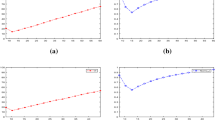Abstract
In Part 1 of this study (Ref. 1), we have defined the implicit complementarity problem and investigated its existence and uniqueness of solution. In the present paper, we establish a convergence theory for a certain iterative algorithm to solve the implicit complementarity problem. We also demonstrate how the algorithm includes as special cases many existing iterative methods for solving a linear complementarity problem.
Similar content being viewed by others
References
Pang, J. S.,The Implicit Complementarity Problem, Nonlinear Programming 4, Edited by O. L. Mangasarian, R. R. Meyer, and S. M. Robinson, Academic Press, New York, New York, 1981.
Aganagic, M.,Iterative Methods for Linear Complementarity Problems, Stanford University, Systems Optimization Laboratory, Technical Report No. SOL 78–10, 1978.
Ahn, B. H.,Computation of Asymmetric Linear Complementarity Problems by Iterative Methods, Journal of Optimization Theory and Applications, Vol. 33, pp. 175–185, 1981.
Cottle, R. W., andGoheen, M.,A Special Class of Large Quadratic Programs, Nonlinear Programming 3, Edited by O. L. Mangasarian, R. R. Meyer, and S. M. Robinson, Academic Press, New York, New York, 1978.
Cottle, R. W., Golub, G., andSacher, R. S.,On the Solution of Large Structured Linear Complementarity Problems: The Block Partitioned Case, Applied Mathematics and Optimization, Vol. 4, pp. 347–363, 1978.
Cryer, C. W.,The Solution of Quadratic Programming Problems Using Systematic Overrelaxation, SIAM Journal on Control, Vol. 9, pp. 385–392, 1971.
Mangasarian, O. L.,Solution of Symmetric Linear Complementarity Problems by Iterative Methods, Journal of Optimization Theory and Applications, Vol. 22, pp. 465–485, 1977.
Ortega, J. M.,Numerical Analysis, A Second Course, Academic Press, New York, New York, 1972.
Varga, R. S.,On Recurring Theorems on Diagonal Dominance, Linear Algebra and Its Applications, Vol. 13, pp. 1–9, 1976.
Ostrowski, A. M.,Uber die Determinanten mit Uberwirgender Hauptdiagonale, Commentarii Mathematici Helvetici, Vol. 10, pp. 69–96, 1937.
Pang, J. S.,Hidden Z-Matrices with Positive Principal Minors, Linear Algebra and Its Applications, Vol. 22, pp. 267–281, 1978.
Fiedler, M., andPták, V.,On Matrices with Nonpositive Off-Diagonal Elements and Positive Principal Minors, Czech Journal of Mathematics, Vol. 12, pp. 382–400, 1962.
Plemmons, R. J.,M-Matrix Characterization, I: Nonsingular M-Matrices, Linear Algebra and Its Applications, Vol. 18, pp. 175–188, 1977.
Varga, R. S.,Matrix Iterative Analysis, Prentice-Hall, Englewood Cliffs, New Jersey, 1962.
Author information
Authors and Affiliations
Additional information
Communicated by O. L. Mangasarian
This research was prepared as part of the activities of the Management Sciences Research Group, Carnegie-Mellon University, under Contract No. N00014-75-C-0621-NR-047-048 with the Office of Naval Research.
Rights and permissions
About this article
Cite this article
Pang, J.S. On the convergence of a basic iterative method for the implicit complementarity problem. J Optim Theory Appl 37, 149–162 (1982). https://doi.org/10.1007/BF00934765
Issue Date:
DOI: https://doi.org/10.1007/BF00934765




